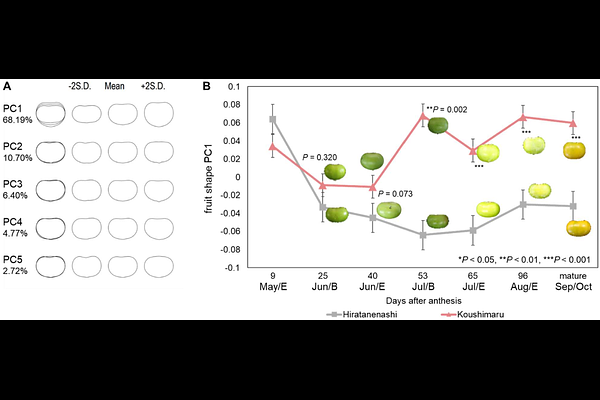Physiological characterization in a somaclonal mutant for fruit shape derived from persimmon 'Hiratanenashi'

Physiological characterization in a somaclonal mutant for fruit shape derived from persimmon 'Hiratanenashi'
Horiuchi, A.; Matsuzaki, R.; Onoue, N.; Ushijima, K.; Kubo, Y.; Akagi, T.; Minamikawa, M. F.
AbstractFruit shape is an essential agronomic trait that contributes to the commercial value of fruit crops; however, the physiological mechanisms determining fruit shape have been studied only in a few model crops. Persimmon (Diospyros kaki Thunb.), a major fruit crop in East Asia, shows diversity in fruit shape among cultivars. The underlying molecular mechanisms that determine fruit shape remain unclear. A comparative physiological analysis was conducted to investigate the differences between a major Japanese cultivar, \'Hiratanenashi\' with a \'\'flat\'\' fruit shape, and its somaclonal mutant cultivar, \'Koushimaru\' with a \'\'round\'\' fruit shape. Through principal component analysis (PCA) with the elliptic Fourier descriptor, the fruit shape transitions in these two cultivars were measured over the fruit differentiation period (40-53 days after anthesis). Histological observation of the mesocarp cells in the fruit shape differentiation stage indicated that not only cell proliferation patterns but also multiple vectors involving cell shapes or sizes are possible determinants of differences in fruit shape. Transcriptome analysis at the fruit shape differentiation stage detected differentially expressed genes between the two cultivars. The hierarchical clustering with expression patterns throughout the fruit development/maturation stages defined four main clusters, including candidate genes determining fruit shapes. We focused on one of these genes, DKAch04a32073.t1, annotated as WUSCHEL related homeobox 13 (WOX13), which has been reported to be a key factor in callus formation (or stem cell proliferation) and the reconnection of organs in Arabidopsis thaliana. Future functional analyses of the candidate genes would provide a better understanding of the mechanisms underlying persimmon fruit shape.